Oh yes, I remember it well. Luise Kimme, a German sculptor who shared my flat in the early 1970s, used to buy plaster copies of Michelangelo’s David, paint them garish colours and give them to friend as presents. More a conceptualist than a lover of kitsch, I meanwhile set projects for my students requiring them to photograph every item of clothing in their wardrobes or to empty their bags and present the contents as self-portraits.
Ideas like these were in the air – part of the zeitgeist – and most of us moved on to other things; but German artist Hans-Peter Feldman spent the next 40 years pursuing similar activities. Susanne in Berlin (pictured below) and Mari in New York are among the women he persuaded to surrender their handbags in return for 500 Euros. They were allowed to retain essential items like keys, credit cards and passports, but everything else – from shoes, mobile phones, purses, coins and make-up to sunglasses, receipts and cigarettes – is neatly arranged in museum-style vitrines alongside the bags, as though they were deeply significant artefacts.
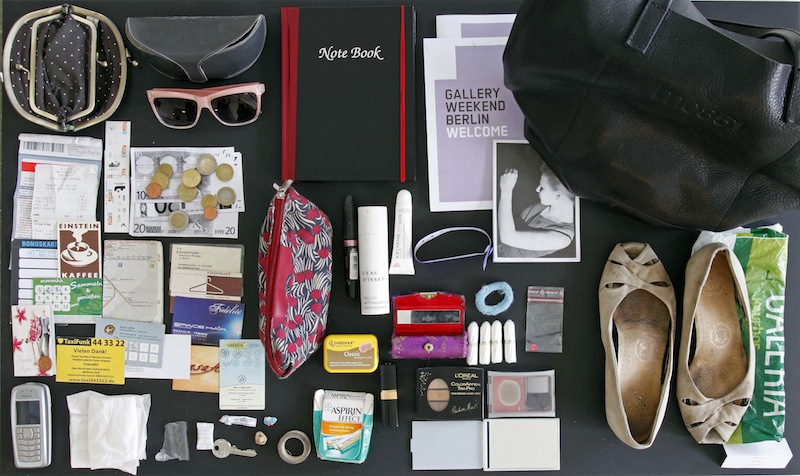 Displayed as a grid of black and white snapshots, All the Clothes of a Woman is one of many sequences cataloguing short-lived collections of things that are often overlooked or taken for granted. My favourites include variously shaped slices of bread and a pound of strawberries in which each fruit is separately photographed in colour. There’s a bath tub supposedly recorded before and after a bath (which one suspects is a spoof, since nothing changes except the bath mat which becomes crumpled), and photographs of car radios apparently playing good music. Self-defeating examples like these humorously remind us of the limitations of photography and how much we take on trust each time we look at a picture.
Displayed as a grid of black and white snapshots, All the Clothes of a Woman is one of many sequences cataloguing short-lived collections of things that are often overlooked or taken for granted. My favourites include variously shaped slices of bread and a pound of strawberries in which each fruit is separately photographed in colour. There’s a bath tub supposedly recorded before and after a bath (which one suspects is a spoof, since nothing changes except the bath mat which becomes crumpled), and photographs of car radios apparently playing good music. Self-defeating examples like these humorously remind us of the limitations of photography and how much we take on trust each time we look at a picture.
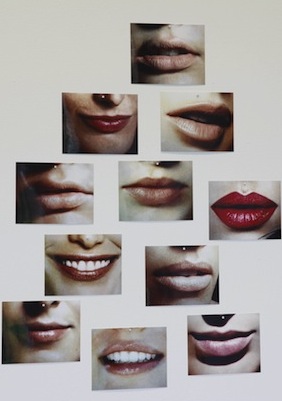 The fraught relationship between images and the world they portray seems to be an ongoing preoccupation. Greeting you on arrival at the Serpentine Gallery are the Sunday Pictures. Colour-supplement escapism is represented by photographs of puppies, foals and kittens, loving couples, waterfalls and sunsets. Drained of colour and reprinted on cheap paper, they become ghostly reflections of the stereotypes and the happiness that they supposedly embody.
The fraught relationship between images and the world they portray seems to be an ongoing preoccupation. Greeting you on arrival at the Serpentine Gallery are the Sunday Pictures. Colour-supplement escapism is represented by photographs of puppies, foals and kittens, loving couples, waterfalls and sunsets. Drained of colour and reprinted on cheap paper, they become ghostly reflections of the stereotypes and the happiness that they supposedly embody.
My friend Luise imbued her market-stall masterpieces with a twist of surrealism by painting them bright red or blue, but Feldmann is playing a more subtle game. His David has been given hot pink flesh and blond hair – a crude approximation of the colours the ancient Greeks painted the marble statues that would later inspire Michelangelo. How, one wonders, would Renaissance artists have responded had they seen the originals gaudily coated in bright colours instead of bleached to pallid good taste?
David stands near Aphrodite in front of a wall dotted with plastic flowers in plastic pots (main picture), whose relationship to the real thing is as tenuous as that of the plaster cast either to Michelangelo’s sculpture or a male nude. In front of them is a wall of seascapes that are remarkably similar, since their undulating waves and cloudy skies conform to a romantic notion of the elements as conjured by the brushes of amateur artists. They reminded me of an elderly gentleman in one of my evening classes; resisting all my attempts to “free” him up, week after week he doggedly copied a landscape from a postcard.
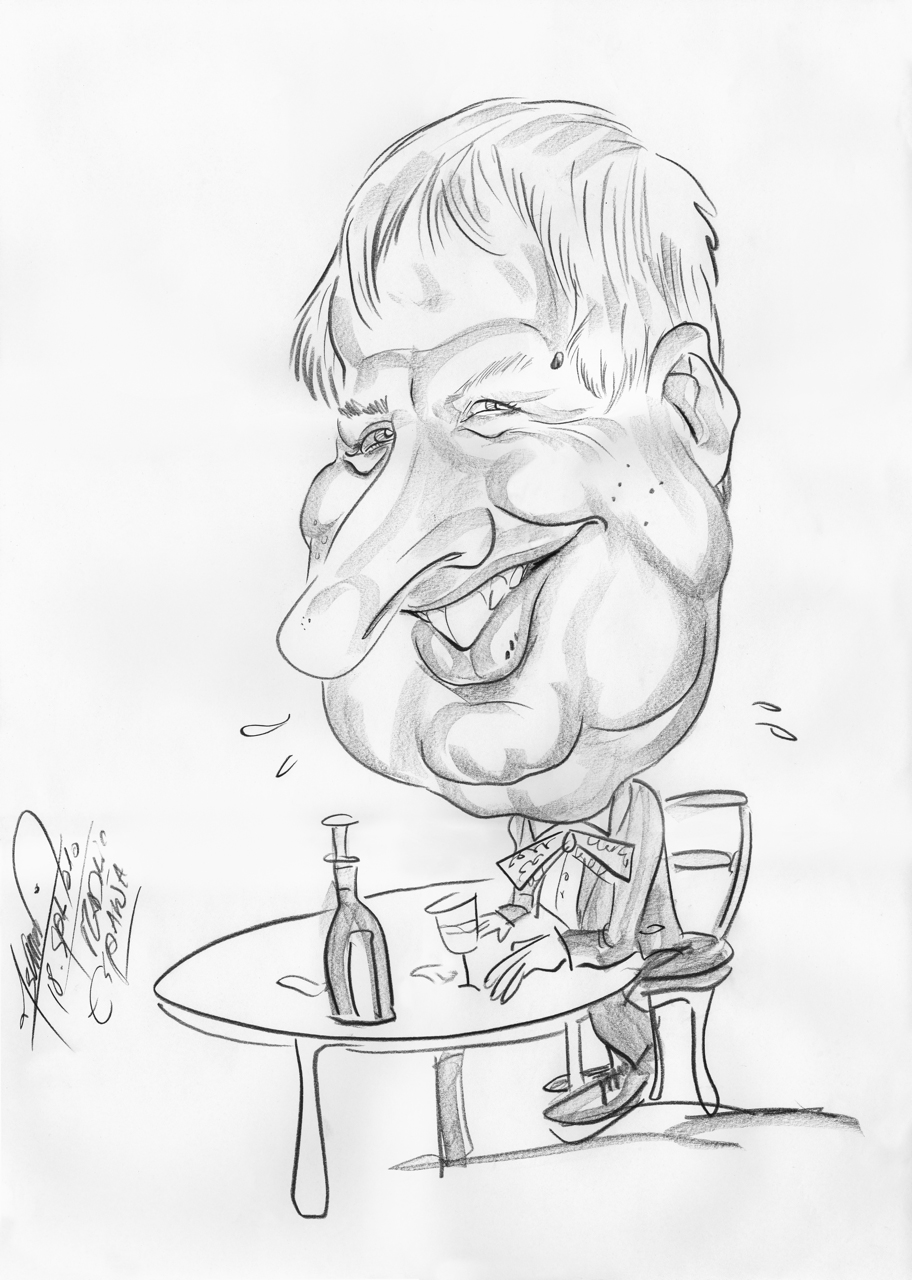 The assemblage forms a rather touching resumé of human ineptitude. It is introduced by the statement “Art must have the right to risk being bad” which is collaged from capital letters cut from newspaper headlines, like a Sex Pistols provocation. And as though to hammer the point home, another wall is covered with execrable caricatures of Feldmann drawn in 2010 by street artists in Madrid (pictured right).
The assemblage forms a rather touching resumé of human ineptitude. It is introduced by the statement “Art must have the right to risk being bad” which is collaged from capital letters cut from newspaper headlines, like a Sex Pistols provocation. And as though to hammer the point home, another wall is covered with execrable caricatures of Feldmann drawn in 2010 by street artists in Madrid (pictured right).
Elsewhere touches of surrealist humour pay tribute to Marcel Broodthaers (in a tower of black homburgs) and Man Ray, who famously glued a row of tacks onto an iron. Feldmann has lined a pair gold stilettos with drawing pins (pictured below) and, where Man Ray painted f holes on a model’s back to mimic a cello, Feldmann has added them to the back of an academic nude. Other nudes have been “censored” with the addition of black bars painted across their eyes, nipples or groins and dull portraits enlivened with clown noses or crossed eyes.
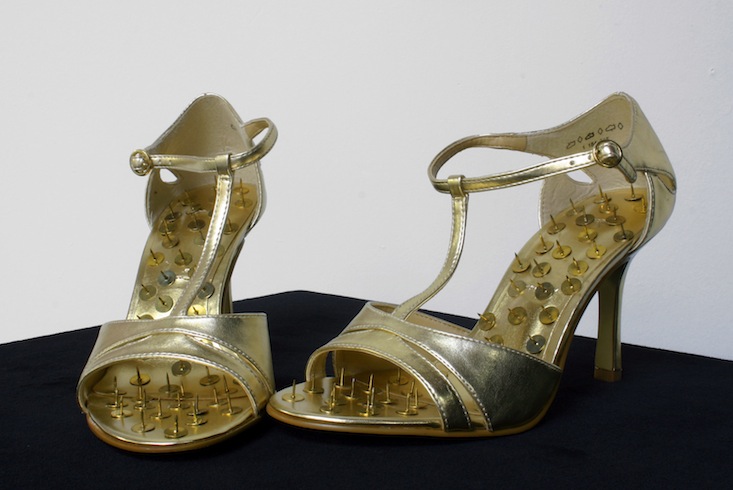 Bad art, kitsch sentimentality, clichés and stereotypes; it could be rather patronising if it weren’t for Feldmann’s obvious affection for the things he collects so avidly and his ability to set them in conversation with each another. Shadow Play (pictured below) is a series of tiny, illuminated tableaux; chosen from his vast collection of trinkets and toys, a plastic aeroplane, wire butterfly, wooden duck, plastic doll’s head and a dog doing a headstand meet on a revolving disc. Dancing across the far wall, their shadows cross paths with that of a Barbie doll, the Eiffel Tower, Spiderman, dinosaur bones and a steam engine, angels and newlyweds in a ghostly parade of archetypes; execrable kitsch is transformed into a display that induces a child-like sense of wonder. And because you can see how its done, it really does feel like magic.
Bad art, kitsch sentimentality, clichés and stereotypes; it could be rather patronising if it weren’t for Feldmann’s obvious affection for the things he collects so avidly and his ability to set them in conversation with each another. Shadow Play (pictured below) is a series of tiny, illuminated tableaux; chosen from his vast collection of trinkets and toys, a plastic aeroplane, wire butterfly, wooden duck, plastic doll’s head and a dog doing a headstand meet on a revolving disc. Dancing across the far wall, their shadows cross paths with that of a Barbie doll, the Eiffel Tower, Spiderman, dinosaur bones and a steam engine, angels and newlyweds in a ghostly parade of archetypes; execrable kitsch is transformed into a display that induces a child-like sense of wonder. And because you can see how its done, it really does feel like magic.
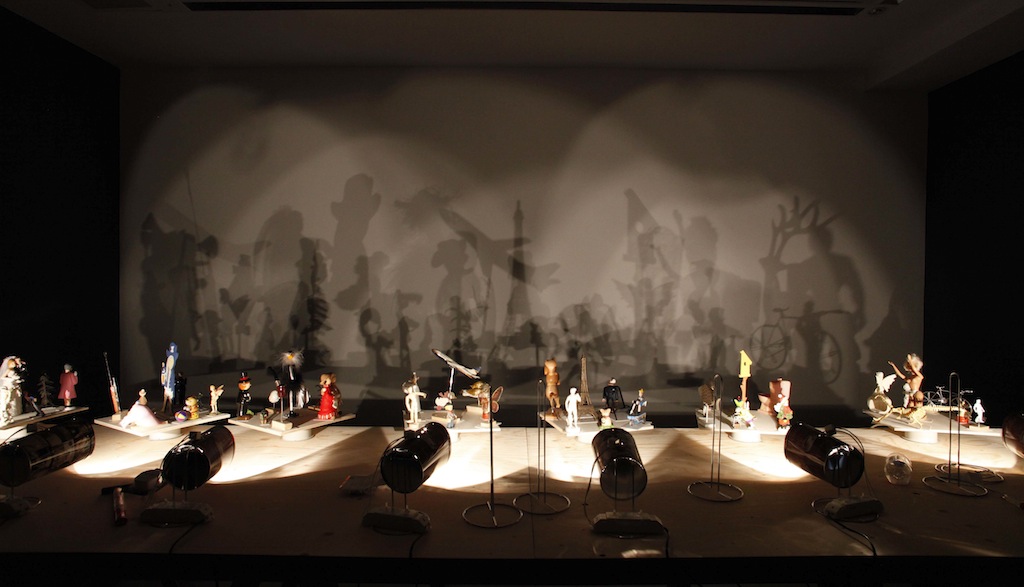
- Hans-Peter Feldmann at the Serpentine Gallery until 5 June

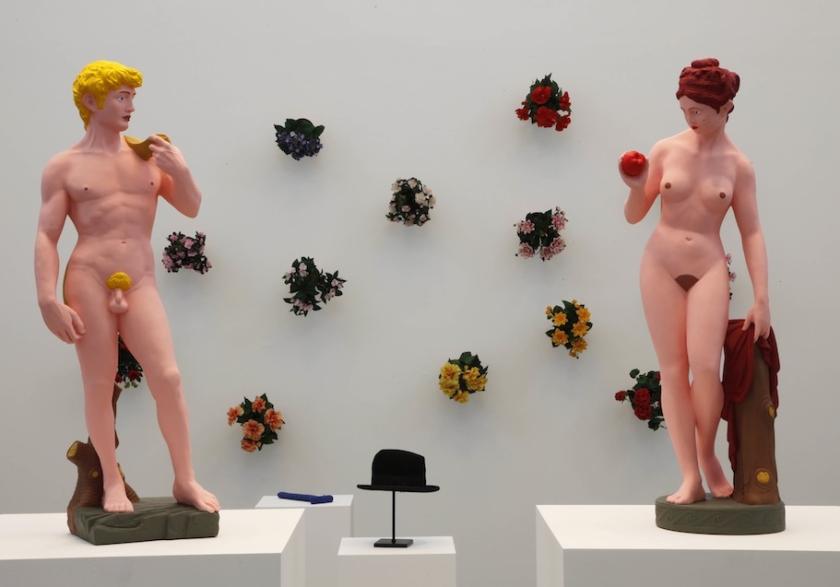








![SEX MONEY RACE RELIGION [2016] by Gilbert and George. Installation shot of Gilbert & George 21ST CENTURY PICTURES Hayward Gallery](/sites/default/files/styles/thumbnail_125_x_125_/public/mastimages/Gilbert%20%26%20George_%2021ST%20CENTURY%20PICTURES.%20SEX%20MONEY%20RACE%20RELIGION%20%5B2016%5D.%20Photo_%20Mark%20Blower.%20Courtesy%20of%20the%20Gilbert%20%26%20George%20and%20the%20Hayward%20Gallery._0.jpg?itok=3oW-Y84i)




Add comment